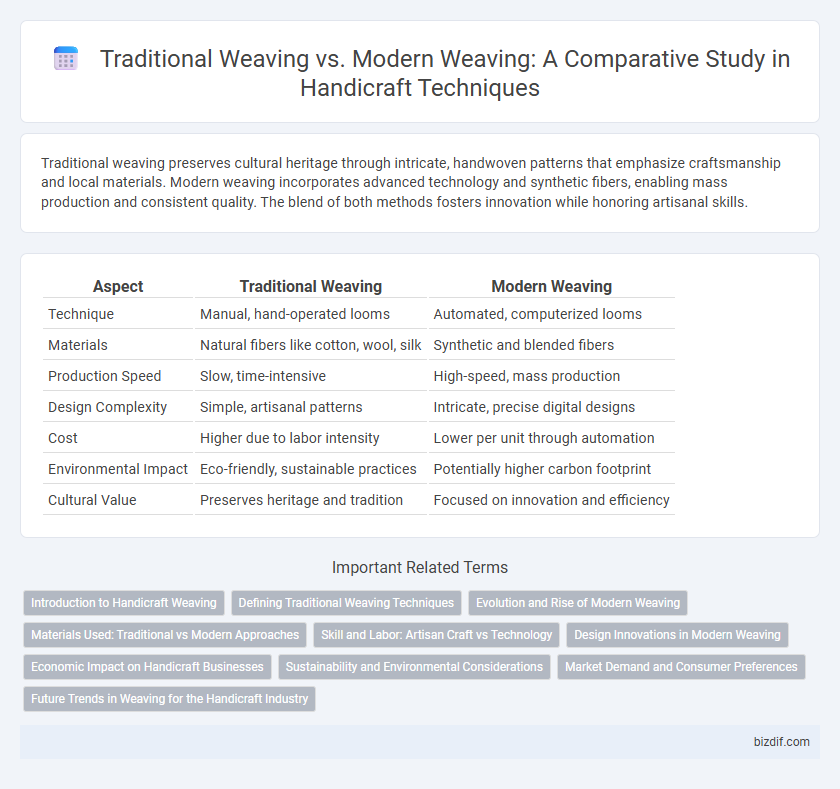Traditional weaving preserves cultural heritage through intricate, handwoven patterns that emphasize craftsmanship and local materials. Modern weaving incorporates advanced technology and synthetic fibers, enabling mass production and consistent quality. The blend of both methods fosters innovation while honoring artisanal skills.
Table of Comparison
| Aspect | Traditional Weaving | Modern Weaving |
|---|---|---|
| Technique | Manual, hand-operated looms | Automated, computerized looms |
| Materials | Natural fibers like cotton, wool, silk | Synthetic and blended fibers |
| Production Speed | Slow, time-intensive | High-speed, mass production |
| Design Complexity | Simple, artisanal patterns | Intricate, precise digital designs |
| Cost | Higher due to labor intensity | Lower per unit through automation |
| Environmental Impact | Eco-friendly, sustainable practices | Potentially higher carbon footprint |
| Cultural Value | Preserves heritage and tradition | Focused on innovation and efficiency |
Introduction to Handicraft Weaving
Traditional weaving in handicraft emphasizes intricate manual techniques passed down through generations, utilizing natural fibers such as cotton, wool, and silk to create culturally significant patterns and textures. Modern weaving integrates advanced technology like computerized looms and synthetic materials, enabling mass production and innovative designs while maintaining the essence of craftsmanship. The evolution from traditional to modern weaving reflects a balance between preserving heritage and embracing efficiency in the textile industry.
Defining Traditional Weaving Techniques
Traditional weaving techniques encompass hand-operated looms and methods passed down through generations, emphasizing natural fibers like cotton, wool, and silk. These techniques involve intricate patterns and cultural motifs that reflect regional identities and artisanship. The meticulous process relies on manual skills and time-honored practices, contrasting sharply with the mechanized precision of modern weaving.
Evolution and Rise of Modern Weaving
Traditional weaving embodies centuries-old techniques passed down through generations, characterized by manual loom operation and natural fibers, resulting in unique, artisanal textiles. The rise of modern weaving incorporates advanced machinery, synthetic materials, and digital design tools, significantly increasing production speed and fabric consistency. This evolution reflects the textile industry's shift toward mass production while still influencing contemporary fashion and interior design with its blend of innovation and cultural heritage.
Materials Used: Traditional vs Modern Approaches
Traditional weaving utilizes natural fibers such as cotton, wool, silk, and flax, often sourced locally and dyed with organic pigments, emphasizing sustainability and cultural heritage. Modern weaving incorporates synthetic fibers like nylon, polyester, and acrylic, offering enhanced durability, elasticity, and mass production efficiency. The choice of materials directly influences the texture, strength, and environmental impact of the final textile product.
Skill and Labor: Artisan Craft vs Technology
Traditional weaving relies heavily on artisan skill, requiring intricate hand movements and deep knowledge of patterns developed over generations, which makes each piece unique and labor-intensive. Modern weaving uses advanced technology such as automated looms and digital designs to increase efficiency, reduce production time, and maintain consistency in fabric quality. The contrast between these methods highlights the value of human craftsmanship in traditional weaving and the scalability offered by technological innovation in modern weaving.
Design Innovations in Modern Weaving
Modern weaving incorporates advanced technologies and diverse synthetic fibers to create intricate patterns and vibrant color palettes that are difficult to achieve with traditional methods. Digital tools enable precise control over thread placement, allowing for complex geometric and abstract designs that expand artistic expression. These innovations enhance durability and functionality while preserving the aesthetic essence of handwoven textiles.
Economic Impact on Handicraft Businesses
Traditional weaving supports local economies by sustaining artisanal skills and creating unique, high-value products that attract niche markets and tourists. Modern weaving, utilizing advanced machinery, increases production scale and lowers costs, enabling businesses to meet mass-market demand but often reducing handmade product authenticity. Handicraft businesses balancing both methods can optimize profitability by blending cultural heritage with efficient production techniques.
Sustainability and Environmental Considerations
Traditional weaving employs natural fibers and dyes, minimizing environmental impact through biodegradable materials and low energy use. Modern weaving often relies on synthetic fibers and chemical dyes, which can contribute to pollution and resource depletion. Emphasizing sustainable practices, many artisans integrate eco-friendly materials and renewable energy to reduce the ecological footprint of contemporary textile production.
Market Demand and Consumer Preferences
Traditional weaving continues to attract niche markets seeking authentic, handmade textiles with cultural significance, especially in regions valuing heritage crafts. Modern weaving leverages advanced machinery to meet large-scale production demands, appealing to consumers prioritizing affordability and uniformity. Market demand shifts reflect consumer preferences balancing artisanal quality against cost-efficiency and mass availability.
Future Trends in Weaving for the Handicraft Industry
Future trends in weaving for the handicraft industry emphasize the integration of sustainable materials and digital technologies, enhancing efficiency while preserving artisanal techniques. Smart looms and AI-driven design tools enable personalized patterns and faster production, meeting growing consumer demand for unique, eco-friendly products. The fusion of tradition with innovation positions the handicraft weaving sector for expanded global markets and sustainable growth.
Traditional weaving vs Modern weaving Infographic

 bizdif.com
bizdif.com